�
Cognitive Radio Networks
Cognitive Radio Networks Kwang-Cheng Chen and Ramjee Prasad
© 2009 John Wiley & Sons Ltd. ISBN: 978-0-470-69689-7
Cognitive Radio Networks
Professor Kwang-Cheng Chen
National Taiwan University, Taiwan
Professor Ramjee Prasad
Aalborg University, Denmark
�
This edition first published 2009
# 2009 by John Wiley & Sons Ltd
Registered office
John Wiley & Sons Ltd, The Atrium, Southern Gate, Chichester, West Sussex, PO19 8SQ, United Kingdom
For details of our global editorial offices, for customer services and for information about how to apply for permission to
reuse the copyright material in this book please see our website at www.wiley.com.
The right of the author to be identified as the author of this work has been asserted in accordance with the Copyright,
Designs and Patents Act 1988.
All rights reserved. No part of this publication may be reproduced, stored in a retrieval system, or transmitted, in any
form or by any means, electronic, mechanical, photocopying, recording or otherwise, except as permitted by the UK
Copyright, Designs and Patents Act 1988, without the prior permission of the publisher.
Wiley also publishes its books in a variety of electronic formats. Some content that appears in print may not be available
in electronic books.
Designations used by companies to distinguish their products are often claimed as trademarks. All brand names and
product names used in this book are trade names, service marks, trademarks or registered trademarks of their respective
owners. The publisher is not associated with any product or vendor mentioned in this book. This publication is designed
to provide accurate and authoritative information in regard to the subject matter covered. It is sold on the understanding
that the publisher is not engaged in rendering professional services. If professional advice or other expert assistance is
required, the services of a competent professional should be sought.
Library of Congress Cataloging-in-Publication Data
Chen, Kwang-Cheng.
Cognitive radio networks / Kwang-Cheng Chen, Ramjee Prasad.
p. cm.
Includes bibliographical references and index.
ISBN 978-0-470-69689-7 (cloth)
1. Cognitive radio networks. I. Prasad, Ramjee. II. Title.
TK5103.4815.C48 2009
0
621.39
81–dc22
2008055907
A catalogue record for this book is available from the British Library.
ISBN 978-0-470-69689-7
Set in 10/12pt Times by Thomson Digital, Noida, India.
Printed in Great Britain by CPI Anthony Rowe, Chippenham, England
�
Contents
Preface
1 Wireless Communications
1.1 Wireless Communications Systems
1.2 Orthogonal Frequency Division Multiplexing (OFDM)
1.2.1 OFDM Concepts
1.2.2 Mathematical Model of OFDM System
1.2.3 OFDM Design Issues
1.2.4 OFDMA
1.3 MIMO
Space-Time Codes
Spatial Multiplexing Using Adaptive Multiple Antenna Techniques
1.3.1
1.3.2
1.3.3 Open-loop MIMO Solutions
1.3.4 Closed-loop MIMO Solutions
1.3.5 MIMO Receiver Structure
1.4 Multi-user Detection (MUD)
1.4.1 Multi-user (CDMA) Receiver
1.4.2
References
Suboptimum DS/CDMA Receivers
2 Software Defined Radio
2.1 Software Defined Radio Architecture
2.2 Digital Signal Processor and SDR Baseband Architecture
2.3 Reconfigurable Wireless Communication Systems
2.3.1 Unified Communication Algorithm
2.3.2 Reconfigurable OFDM Implementation
2.3.3 Reconfigurable OFDM and CDMA
2.4 Digital Radio Processing
2.4.1 Conventional RF
2.4.2 Digital Radio Processing (DRP) Based System Architecture
References
3 Wireless Networks
3.1 Multiple Access Communications and ALOHA
3.1.1 ALOHA Systems and Slotted Multiple Access
3.1.2
Slotted ALOHA
xi
1
1
3
4
5
9
21
24
24
27
27
29
31
34
34
37
40
41
41
43
46
46
47
47
48
48
52
58
59
60
61
61
�
vi
Contents
Stabilised Slotted ALOHA
3.1.3
3.1.4 Approximate Delay Analysis
3.1.5 Unslotted ALOHA
3.2 Splitting Algorithms
3.2.1 Tree Algorithms
3.2.2 FCFS Splitting Algorithm
3.2.3 Analysis of FCFS Splitting Algorithm
3.3 Carrier Sensing
3.3.1 CSMA Slotted ALOHA
3.3.2
3.3.3 Carrier Sense Multiple Access with Collision Detection (CSMA/CD)
Slotted CSMA
3.4 Routing
Shortest Path Routing
3.4.1 Flooding and Broadcasting
3.4.2
3.4.3 Optimal Routing
3.4.4 Hot Potato (Reflection) Routing
3.4.5 Cut-through Routing
3.4.6
3.4.7
Interconnected Network Routing
Shortest Path Routing Algorithms
3.5 Flow Control
3.5.1 Window Flow Control
3.5.2 Rate Control Schemes
3.5.3 Queuing Analysis of the Leaky Bucket Scheme
References
4 Cooperative Communications and Networks
4.1
Information Theory for Cooperative Communications
4.1.1 Fundamental Network Information Theory
4.1.2 Multiple-access Channel with Cooperative Diversity
4.2 Cooperative Communications
4.2.1 Three-Node Cooperative Communications
4.2.2 Multiple-Node Relay Network
4.3 Cooperative Wireless Networks
4.3.1 Benefits of Cooperation in Wireless Networks
4.3.2 Cooperation in Cluster-Based Ad-hoc Networks
References
5 Cognitive Radio Communications
5.1 Cognitive Radios and Dynamic Spectrum Access
Spectrum Sharing Models of DSA
5.1.1 The Capability of Cognitive Radios
5.1.2
5.1.3 Opportunistic Spectrum Access: Basic Components
5.1.4 Networking The Cognitive Radios
5.2 Analytical Approach and Algorithms for Dynamic Spectrum Access
5.2.1 Dynamic Spectrum Access in Open Spectrum
5.2.2 Opportunistic Spectrum Access
5.2.3 Opportunistic Power Control
5.3 Fundamental Limits of Cognitive Radios
64
65
66
66
67
68
69
71
71
76
79
82
83
83
83
84
84
84
84
89
89
91
92
93
95
96
96
101
102
103
109
113
114
116
118
121
121
122
124
126
126
126
128
130
131
132
�
Contents
5.4 Mathematical Models Toward Networking Cognitive Radios
5.4.1 CR Link Model
5.4.2 Overlay CR Systems
5.4.3 Rate-Distance Nature
References
6 Cognitive Radio Networks
6.1 Network Coding for Cognitive Radio Relay Networks
System Model
6.1.1
6.1.2 Network Capacity Analysis on Fundamental CRRN Topologies
6.1.3 Link Allocation
6.1.4 Numerical Results
6.2 Cognitive Radio Networks Architecture
6.2.1 Network Architecture
6.2.2 Links in CRN
6.2.3
IP Mobility Management in CRN
6.3 Terminal Architecture of CRN
6.3.1 Cognitive Radio Device Architecture
6.3.2 Re-configurable MAC
6.3.3 Radio Access Network Selection
6.4 QoS Provisional Diversity Radio Access Networks
6.4.1 Cooperative/Collaborative Diversity and Efficient Protocols
6.4.2
Statistical QoS Guarantees over Wireless Asymmetry
Collaborative Relay Networks
6.5 Scaling Laws of Ad-hoc and Cognitive Radio Networks
6.5.1 Network and Channel Models
6.5.2 Ad-hoc Networks
6.5.3 Cognitive Radio Networks
References
7 Spectrum Sensing
7.1 Spectrum Sensing to Detect Specific Primary System
7.1.1 Conventional Spectrum Sensing
7.1.2 Power Control
7.1.3 Power-Scaling Power Control
7.1.4 Cooperative Spectrum Sensing
7.2 Spectrum Sensing for Cognitive OFDMA Systems
7.2.1 Cognitive Cycle
7.2.2 Discrimination of States of the Primary System
7.2.3
Spectrum Sensing Procedure
7.3 Spectrum Sensing for Cognitive Multi-Radio Networks
7.3.1 Multiple System Sensing
7.3.2 Radio Resource Sensing
References
8 Medium Access Control
8.1 MAC for Cognitive Radios
vii
136
136
137
140
142
145
146
147
150
154
156
159
159
161
163
165
165
168
169
171
172
174
177
177
178
179
180
183
183
183
187
188
190
194
195
197
203
206
207
216
228
231
231
�
viii
Contents
8.2 Multichannel MAC
8.2.1 General Description of Multichannel MAC
8.2.2 Multichannel MAC: Collision Avoidance/Resolution
8.2.3 Multichannel MAC: Access Negotiation
8.3 Slotted-ALOHA with Rate-Distance Adaptability
8.3.1
System Model
8.4 CSMA with AMC
8.4.1 Carrier Sense Multiple Access with Spatial-Reuse
Transmissions
8.4.2 Analysis of CSMA-ST
8.4.3 A Cross-Layer Power-Rate Control Scheme
8.4.4 Performance Evaluations
References
9 Network Layer Design
9.1 Routing in Mobile Ad-hoc Networks
9.1.1 Routing in Mobile Ad-hoc Networks
9.1.2 Features of Routing in CRN
9.1.3 Dynamic Source Routing in MANET
9.1.4 Ad-hoc On-demand Distance Vector (AODV)
9.2 Routing in Cognitive Radio Networks
9.2.1 Trusted Cognitive Radio Networking
9.2.2 Routing of Dynamic and Unidirectional CR Links in CRN
9.3 Control of CRN
9.3.1 Flow Control of CRN
9.3.2 End-to-End Error Control in CRN
9.3.3 Numerical Examples
9.4 Network Tomography
9.5 Self-organisation in Mobile Communication Networks
9.5.1
9.5.2
References
Self-organised Networks
Self-organised Cooperative and Cognitive Networks
10 Trusted Cognitive Radio Networks
10.1 Framework of Trust in CRN
10.1.1 Mathematical Structure of Trust
10.1.2 Trust Model
10.2 Trusted Association and Routing
10.2.1 Trusted Association
10.2.2 Trusted Routing
10.3 Trust with Learning
10.3.1 Modified Bayesian Learning
10.3.2 Learning Experiments for CRN
10.4 Security in CRN
10.4.1 Security Properties in Cellular Data Networks
10.4.2 Dilemma of CRN Security
232
235
238
242
251
252
259
261
263
268
270
272
275
275
275
276
278
283
286
286
288
291
291
292
292
296
298
298
299
304
307
308
308
311
311
312
317
319
319
322
328
328
330
�
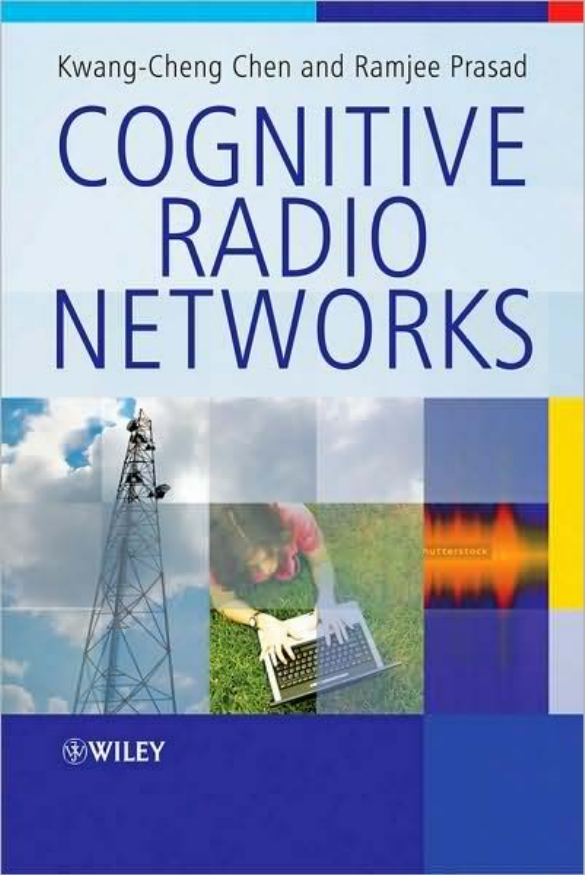

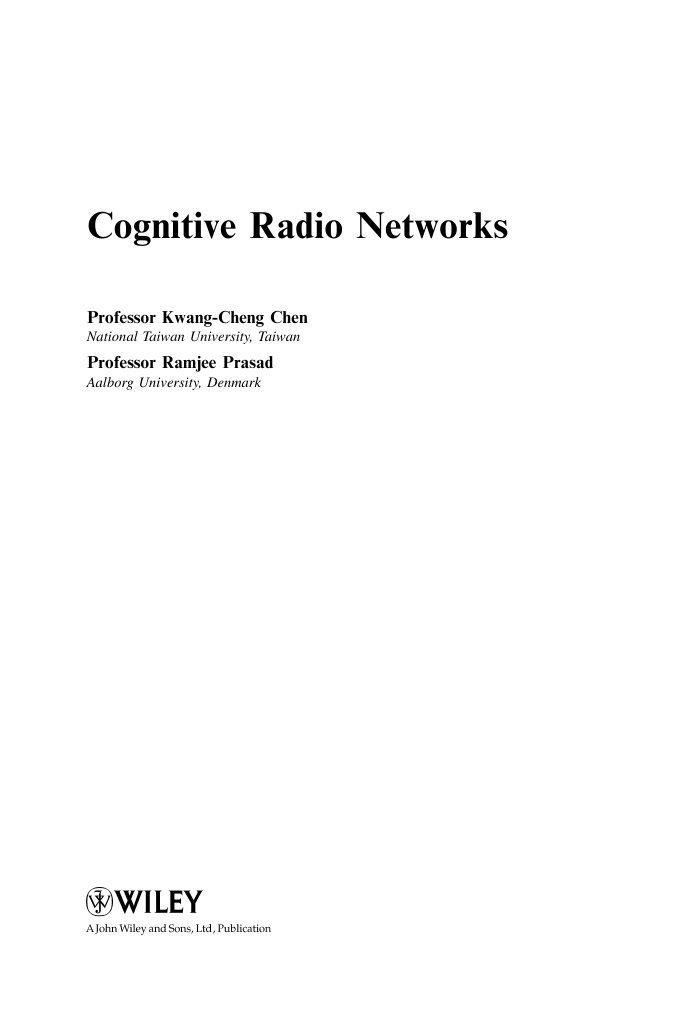
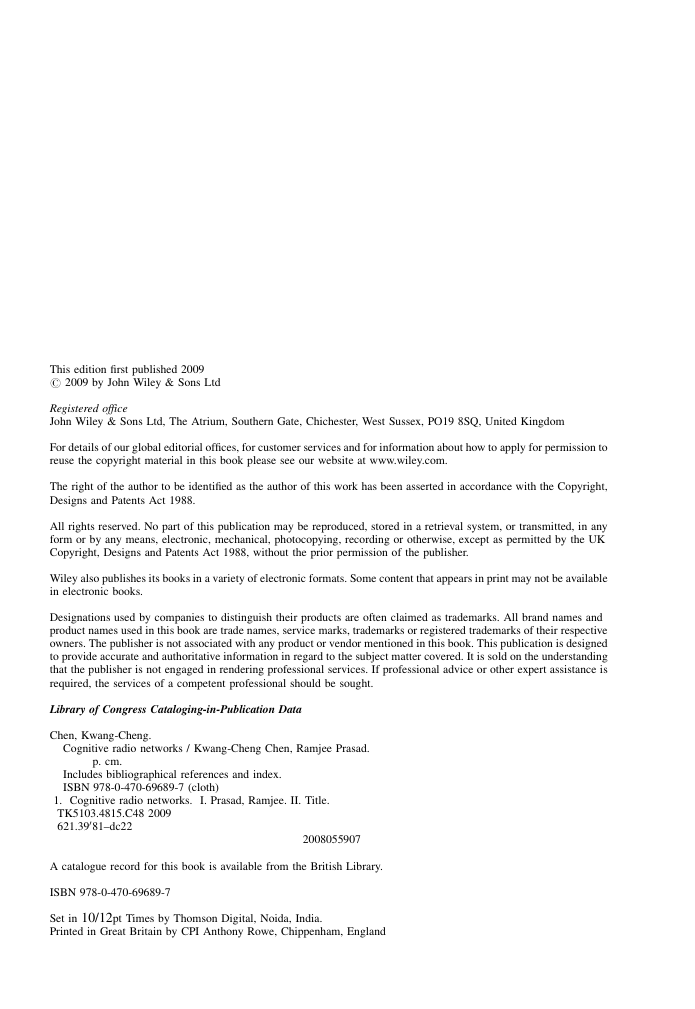
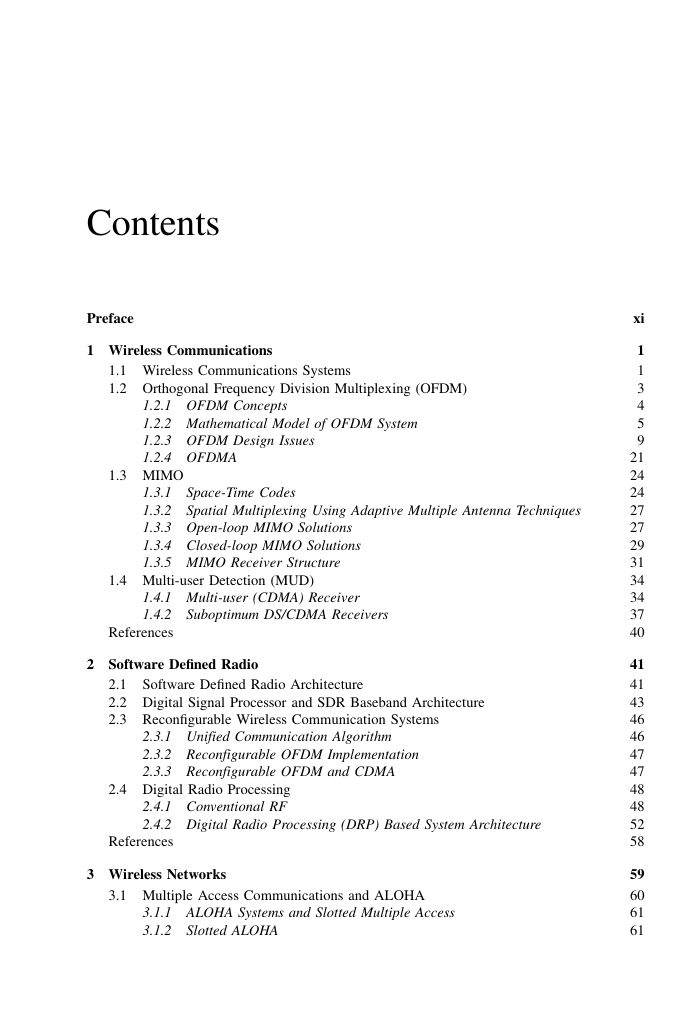
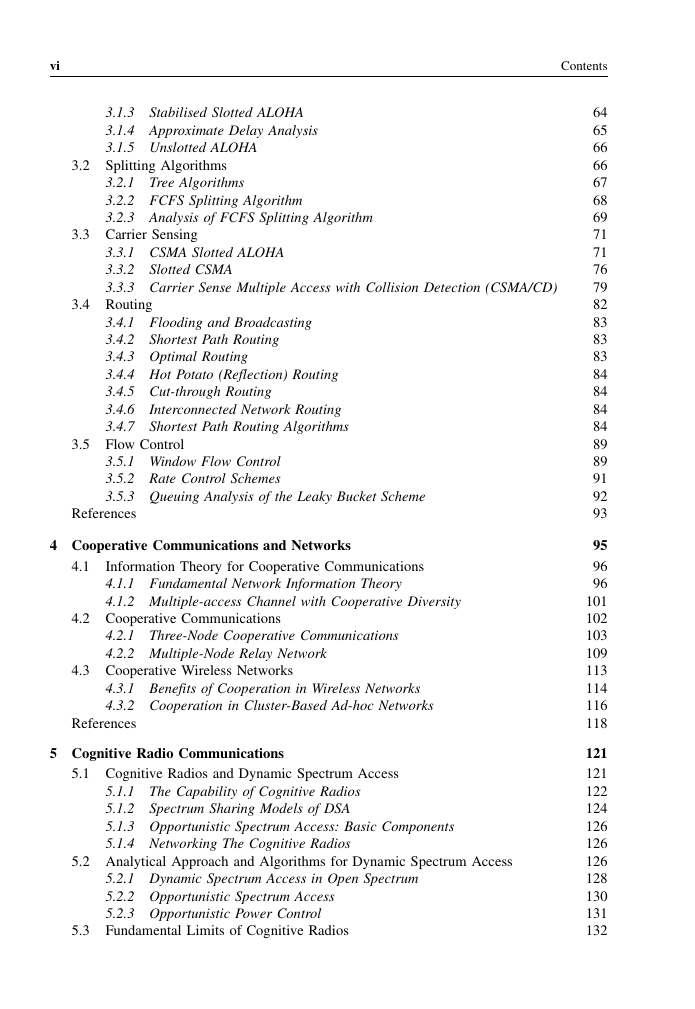
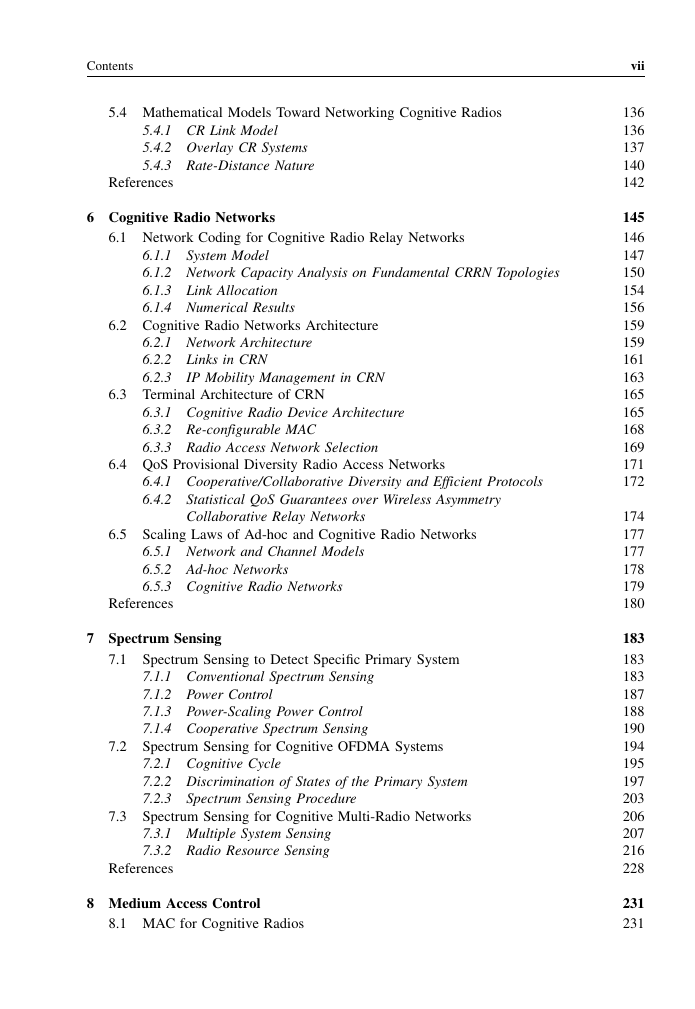
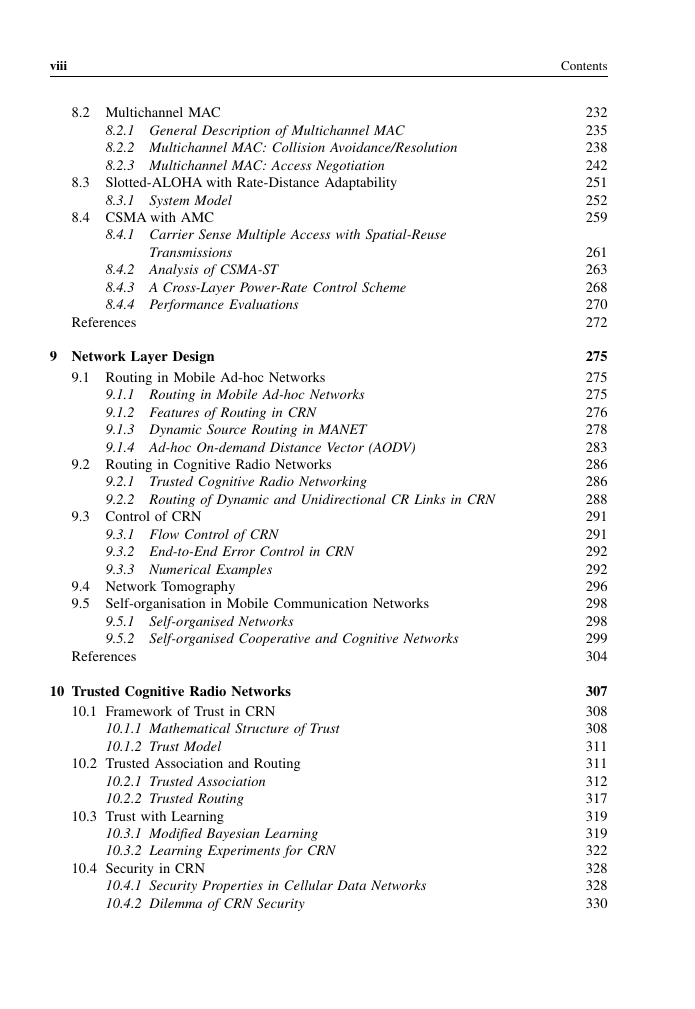








 2023年江西萍乡中考道德与法治真题及答案.doc
2023年江西萍乡中考道德与法治真题及答案.doc 2012年重庆南川中考生物真题及答案.doc
2012年重庆南川中考生物真题及答案.doc 2013年江西师范大学地理学综合及文艺理论基础考研真题.doc
2013年江西师范大学地理学综合及文艺理论基础考研真题.doc 2020年四川甘孜小升初语文真题及答案I卷.doc
2020年四川甘孜小升初语文真题及答案I卷.doc 2020年注册岩土工程师专业基础考试真题及答案.doc
2020年注册岩土工程师专业基础考试真题及答案.doc 2023-2024学年福建省厦门市九年级上学期数学月考试题及答案.doc
2023-2024学年福建省厦门市九年级上学期数学月考试题及答案.doc 2021-2022学年辽宁省沈阳市大东区九年级上学期语文期末试题及答案.doc
2021-2022学年辽宁省沈阳市大东区九年级上学期语文期末试题及答案.doc 2022-2023学年北京东城区初三第一学期物理期末试卷及答案.doc
2022-2023学年北京东城区初三第一学期物理期末试卷及答案.doc 2018上半年江西教师资格初中地理学科知识与教学能力真题及答案.doc
2018上半年江西教师资格初中地理学科知识与教学能力真题及答案.doc 2012年河北国家公务员申论考试真题及答案-省级.doc
2012年河北国家公务员申论考试真题及答案-省级.doc 2020-2021学年江苏省扬州市江都区邵樊片九年级上学期数学第一次质量检测试题及答案.doc
2020-2021学年江苏省扬州市江都区邵樊片九年级上学期数学第一次质量检测试题及答案.doc 2022下半年黑龙江教师资格证中学综合素质真题及答案.doc
2022下半年黑龙江教师资格证中学综合素质真题及答案.doc